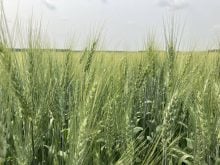INTERNATIONAL PEACE GARDEN, Manitoba-North Dakota border — Planting trees to establish or rejuvenate a windbreak isn’t the backbreaking work it once was.
The hardest part just might be convincing farmers they need to do it.
Shelter belts are still an important part of conservation agriculture, said experts at a recent Canada-U.S. windbreak conference.
Advances in minimum tillage technology have helped prevent soil erosion, which is a job that shelter belts once held, but trees play other significant roles. They act as filters for air pollution and wetlands, provide homes to crop pollinators and provide protection from the wind. They can also provide a second income.
Read Also

Container dispute embroils Port of Vancouver
GCT wants to expand its existing container terminal at the Port of Vancouver, but it is running into opposition from the port itself.
High crop prices have increased the temptation to rip out trees in favour of growing more bushels.
John Kort, senior agroforestry researcher at the federal Agroforestry Development Centre in Indian Head, Sask., said shelter belts that were grown in the 1930s and 1940s are old and need to be renovated.
However, ripping them out completely isn’t always the way to go.
Canada and the United States had programs during settlement and after the dust bowl of the 1930s to help farmers plant millions of trees covering thousands of kilometres to prevent soil from blowing away.
Bruce Wight, national forester with the U.S. Department of Agriculture, said these trees have survived stressors such as 2,4-D and insects and are still doing their jobs.
Changes in field size and equipment and changes in attitude are the main reasons why windbreaks are removed or new ones aren’t planted.
Farmers can’t easily manoeuvre around shelter belts with today’s large machinery, but Wight thinks many still see their value.
“I think many landowners still think they have a role to play,” he said. “The past may come back.”
The 2012 drought affecting a large part of the U.S. could change some perspectives on the need for shelter belts.
“Dust storms are still happening,” Wight said at the end of July. “Fifty-three percent of the U.S. is in moderate drought or worse.”
Although the experts know that tree planting has been on a downward trend in both countries for a while, they don’t know exactly how many trees are still on the landscape as field shelter belts, farmyard windbreaks or buffers around water bodies.
In the U.S., both state and federal forest services are using technology such as aerial imagery, satellite sensing and mapping techniques to quantify trees outside of forests.
Cost-share programs are in place to encourage more planting, but it can be an uphill battle.
Richard Warkentin of the Stanley Soil Management Association in Manitoba said education is a big factor. Landowners and farmers often don’t know which species are best suited for the shelter belt or they think its no longer necessary.
“No-till alone can’t do it all,” he said.















